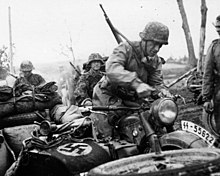
Back Waffen-SS Afrikaans فافن إس إس Arabic Woffen-SS BAR Войскі СС Byelorussian Вафен-СС Bulgarian Waffen-SS Breton Waffen-SS Catalan Waffen-SS Czech Waffen-SS Danish Waffen-SS German
| Waffen-SS | |
|---|---|
 Waffen-SS troops in the Soviet Union, 1941 | |
| Active | 17 March 1933–10 May 1945 |
| Country | |
| Allegiance | |
| Branch | |
| Type | |
| Size | 900,000 including foreign volunteers and conscripts[1] List of Waffen SS units |
| Part of | SS: under operational control of the OKW and Kommandostab Reichsführer-SS |
| Garrison/HQ | SS-Führungshauptamt, Berlin |
| Motto(s) | Meine Ehre heißt Treue[2] (transl. "My honor is called loyalty") |
| Colours | Black White Red |
| Engagements | World War II |
| Commanders | |
| Ceremonial chief | Heinrich Himmler |
| Notable commanders | |
The Waffen-SS (German: [ˈvafn̩ʔɛsˌʔɛs]; lit. 'Armed SS') was the combat branch of the Nazi Party's paramilitary Schutzstaffel (SS) organisation. Its formations included men from Nazi Germany, along with volunteers and conscripts from both German-occupied Europe and unoccupied lands.[3] With the start of World War II, tactical control was exercised by the Oberkommando der Wehrmacht (OKW, "High Command of the Armed Forces"),[4] with some units being subordinated to the Kommandostab Reichsführer-SS (Command Staff Reichsführer-SS) directly under Himmler's control.[5] It was disbanded in May 1945.
The Waffen-SS grew from three regiments to over 38 divisions during World War II. Combining combat and police functions, it served alongside the German Army (Heer), Ordnungspolizei (Order Police), and other security units. Originally, it was under the control of the SS Führungshauptamt (SS operational command office) beneath Reichsführer-SS Heinrich Himmler, the head of the SS.
Initially, in keeping with the racial policy of Nazi Germany, membership was open only to people of Germanic origin (so-called "Aryan ancestry").[6] The rules were partially relaxed in 1940,[7][8] and after the invasion of the Soviet Union in June 1941, Nazi propaganda claimed that the war was a "European crusade against Bolshevism" and subsequently units consisting largely or solely of foreign volunteers and conscripts were also raised.[9] These Waffen-SS units were made up of men mainly from among the nationals of Nazi-occupied Europe. Despite relaxation of the rules, the Waffen-SS was still based on the racist ideology of Nazism, and ethnic Poles (who were viewed as subhumans) were specifically barred from the formations.[10][11][12]
The Waffen-SS were involved in numerous atrocities.[13] It was declared a criminal organisation by the International Military Tribunal in Nuremberg in 1946,[14][15][16] due to its involvement in the Holocaust, the Porajmos, and numerous war crimes and crimes against the civilian population, including torture,[17] human experimentation,[18][19] kidnapping of children,[20] mass rape,[21] child sexual abuse[22] and mass murder.[23][24] Therefore Waffen-SS members, with the exception of conscripts, who comprised about one-third of the membership, were denied many of the rights afforded to military veterans.[14][15][16]
- ^ Neitzel & Welzer 2012, p. 290.
- ^ McConnell, Winder, ed. (1998). A Companion to the Nibelungenlied. Boydell & Brewer. p. 1. ISBN 978-1-57113-151-5. Retrieved 20 May 2022.
- ^ Stein 2002, pp. xxiv, xxv, 150, 153.
- ^ Stein 2002, p. 23.
- ^ Marrus 1989, p. 459.
- ^ Stackelberg 2002, p. 116.
- ^ Langer & Rudowski 2008, p. 263.
- ^ Król 2006, pp. 452, 545.
- ^ Müller & Ueberschär 1997, p. 244.
- ^ Borodziej 1985a.
- ^ Król 2006, p. 452.
- ^ Borodziej 1985, p. 86.
- ^ Spajić 2010, p. 9.
- ^ a b Laar 2005.
- ^ a b "Nuremberg Trial Proceedings, Volume 22 'Two Hundred and Seventeenth Day: Monday, 30 September 1946'". Avalon Project. Lillian Goldman Law Library.
- ^ a b McDonald & Swaak-Goldman 2000, p. 695.
- ^ Serena, Katie (27 November 2017). Kuroski, John (ed.). "Oskar Dirlewanger: The Nazi Who Even Other Nazis Thought Was Cruel And Depraved". All That's Interesting. Retrieved 17 February 2024.
- ^ "Timeline of Dachau". www.jewishvirtuallibrary.org. Retrieved 17 February 2024.
- ^ Wynne Parry (21 February 2014). "Did Nazis Study Insects for Use in Biological Warfare?". livescience.com. Retrieved 17 February 2024.
- ^ "Stolen Children". www.jewishvirtuallibrary.org. Retrieved 17 February 2024.
- ^ "Holocaust". Women’s Media Center. Retrieved 17 February 2024.
- ^ Ghert-Zand, Renee (15 April 2015). "Holocaust film reveals long-hushed child sex abuse". The Times of Israel. Retrieved 17 February 2024.
- ^ "Einsatzgruppen". www.holocaustresearchproject.org. Retrieved 17 February 2024.
- ^ "Operation Reinhard". encyclopedia.ushmm.org. Retrieved 17 February 2024.